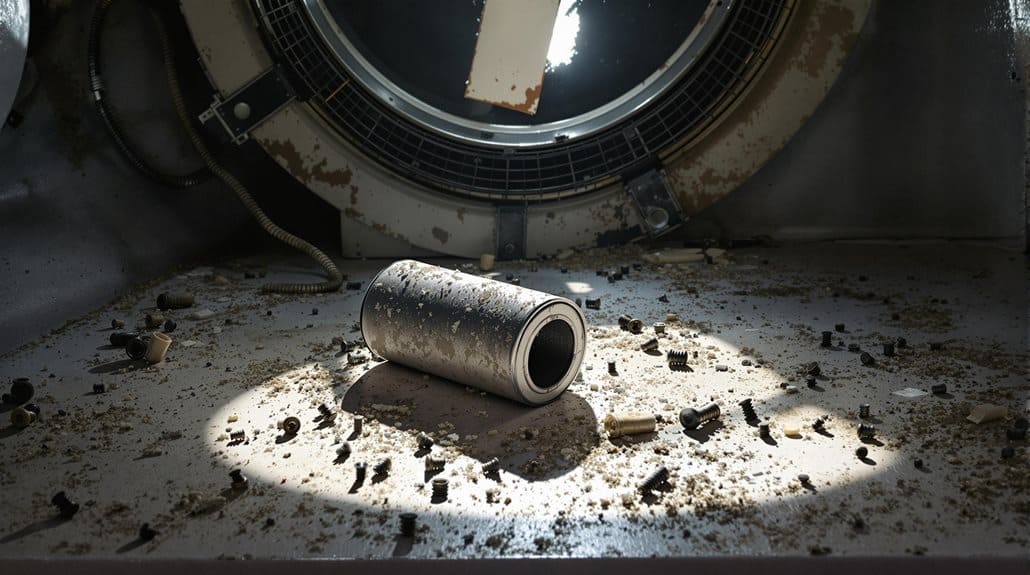Your trusty dryer’s on the fritz, and you’re probably scratching your head, wondering what’s behind the weird noises, damp clothes, and astronomical energy bills. Newsflash: it’s probably begging for repair! If you’re hearing strange thumps, rattles, or squeaks, or if your dryer’s leaving your clothes damp and smelly, it’s time to take notice. And let’s not forget those skyrocketing energy bills – yikes! Whether it’s a faulty heating element, clogged vents, or worn-out parts, there’s likely a culprit behind your dryer’s sorry state. Stick around, and we’ll get to the bottom of this messy laundry business!
Key Takeaways
Quick Fixes to Keep Your Dryer Running Smoothly: Aurora Guide
- Address unusual sounds immediately by checking for loose items and scheduling maintenance – save on costly repairs by catching mechanical issues early.
- Improve drying efficiency by cleaning vents and checking heating elements – reduce energy bills and protect clothes from heat damage while cutting down drying time.
- Prevent unpleasant odors and potential fire hazards with regular lint removal and vent cleaning – maintain safe operation and extend your dryer’s lifespan.
- Save money and energy by promptly addressing heating issues – clean vents quarterly and replace worn heating elements to restore normal operation and prevent overheating.
- Stabilize your dryer’s performance by leveling the unit and replacing worn drum rollers – protect your machine from unnecessary wear while maintaining quiet operation.
Note: Contact a qualified technician for repairs beyond basic maintenance to ensure safe, reliable operation.
Hearing Unusual Dryer Noises
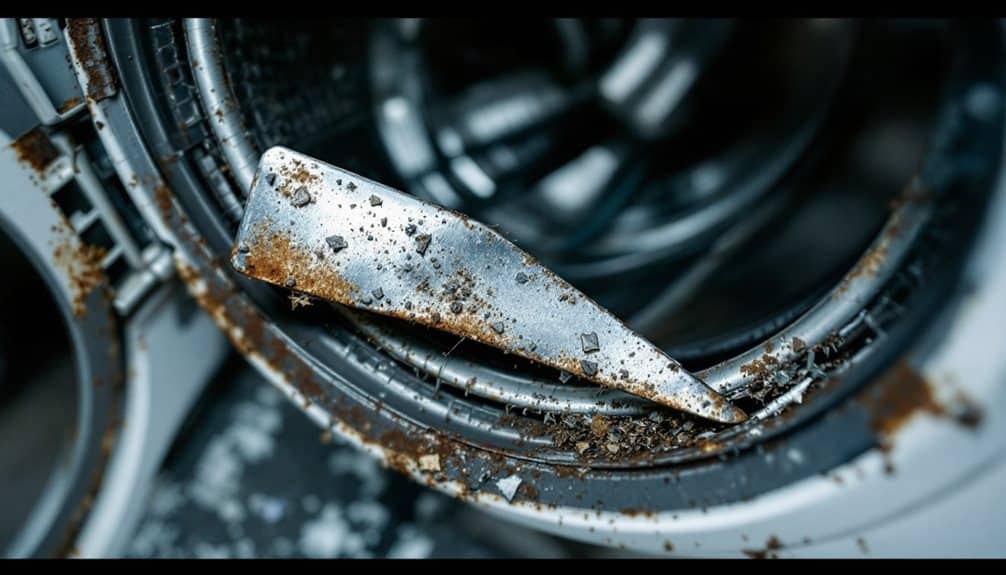
The telltale signs of a dryer in distress – those weird and wonderful noises that make you wonder if your appliance is secretly a wannabe percussionist. You’re folding laundry when suddenly, your dryer starts rattling, squeaking, thumping, or grinding. Don’t worry, it’s not possessed! It’s just crying out for help. To diagnose the issue, you’ll need to pinpoint the source of the noise. Check for loose items like coins or buttons in the drum or blower wheel. If it’s a squeaky sound, a damaged drive belt or worn-out drum bearings might be the culprit. Thumping or banging noises could indicate an unbalanced drum or damaged rollers. Grinding or scraping sounds? That’s likely drum bearing issues or damaged glides. Regular maintenance such as cleaning the lint filter and venting system can prevent some of these noises. Time to get your dryer noise diagnosis on and explore unusual sound remedies! Ignoring these noises may lead to increased risk of complete failure.
Lack of Heat in Dryer
You’re stuck with a dryer that’s as cold as your ex’s heart – it just won’t heat up. Chances are, it’s a faulty heating element, a gas supply problem that just won’t quit, or a clogged vent that’s causing all the drama. It’s also possible that a malfunctioning thermal fuse might be cutting off power to the heating components. Let’s get to the bottom of this heat-less mess and figure out what’s really going on with your dryer. If your dryer’s circuit breaker has tripped, check your electrical panel for a tripped circuit breaker and simply reset the switch to potentially resolve the issue.
Faulty Heating Element Issues
Heat – the unsung hero of doing laundry. Without it, your clothes would be a soggy, smelly mess. So, when your dryer stops producing heat, it’s a major red flag. If your clothes are coming out cold or damp, or the dryer’s running but not heating up, it’s likely a faulty heating element issue. Don’t worry, it’s not the end of the world. You can troubleshoot the problem by checking the electrical source, inspecting the heating element wire, and ensuring the lint screen is clean. But if the issue persists, it may be time to replace the heating element to get your dryer efficiency back on track. A functioning heating element is essential, so don’t let it go unchecked. Regular checks of the thermal fuse can prevent heating issues.
Gas Supply Problems Persist
Behind the scenes of your dryer’s inner workings, a gas supply issue can be the ultimate party crasher – no heat, no fun. You’re expecting a toasty warm load, but instead, you get a chilly surprise. Don’t worry, it’s not the end of the world! First, check the obvious: verify the gas supply line is properly connected and not damaged. A gas line inspection can reveal any kinks or blockages. Next, move on to gas valve troubleshooting – is the valve open and functioning correctly? If the igniter glows but doesn’t ignite, it might be a sign of failed gas valve coils. Grab your multimeter and test for continuity. With a little detective work, you’ll be back to warm, fuzzy socks in no time!
Clogged Vent Causes Issues
Fixing that gas supply issue was just the beginning – your dryer’s now purring like a kitten, but don’t expect a warm welcome just yet. You’ve still got a clogged vent to deal with, and that’s a whole different ball game. You see, a clogged vent is like a ticking time bomb, waiting to wreak havoc on your dryer’s efficiency and your poor clothes. Clothes take forever to dry, the dryer’s hot to the touch, and that lovely burning smell? Yeah, it’s not your dinner – it’s your vent crying for help. Regular vent cleaning is key to preventing all this drama. Get it done at least once a year, and you’ll be golden. Your dryer (and your clothes) will thank you for it.
Incomplete Drying Cycles
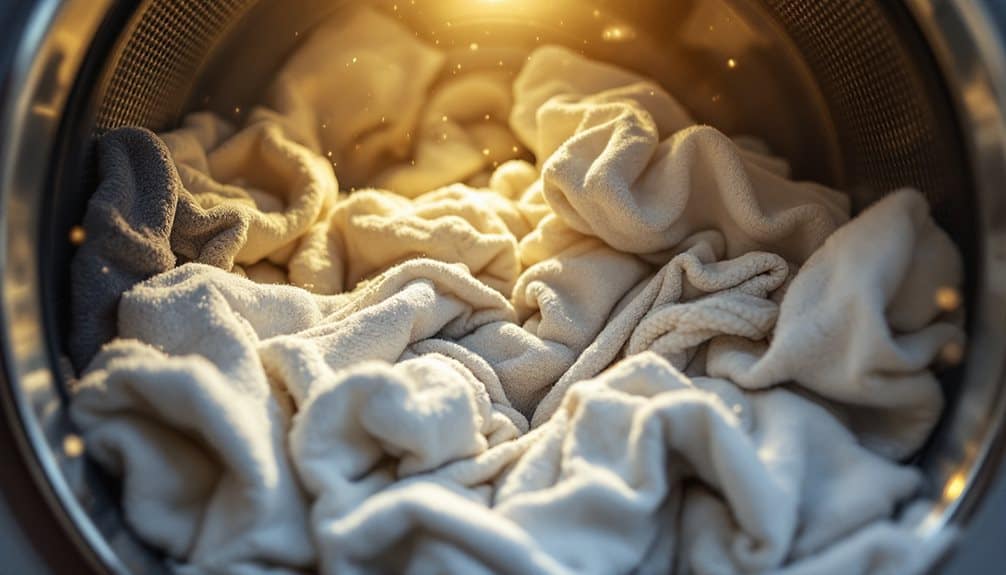
You’re probably tired of dealing with clothes that are still damp after a full cycle, and who can blame you? It’s time to tackle the culprits behind those pesky incomplete drying cycles, starting with a clogged lint screen that’s more clogged than your grandma’s arteries. A worn drum seal can also be the sneaky source of the problem, allowing moisture to seep back in and making you wonder if your dryer is secretly a humidifier. Regular lint filter maintenance is critical for ensuring efficient dryer operation and preventing these drying issues from persisting.
Clogged Lint Screen Issues
Tumbling into the world of dryer woes, clogged lint screens are the ultimate party crashers, ruining the fun of getting your laundry done quickly and efficiently. You know, that pesky screen in the door opening of your dryer is like a magnet for lint, and if you don’t clean it regularly, it’ll cause incomplete drying cycles or early shut-offs. Don’t be that person who lets their dryer turn into a fire hazard!
| Why Clean the Lint Screen? | Lint Screen Maintenance Tips |
|---|---|
| Prevents clogs and fires | Clean the screen after every load |
| Reduces drying times | Roll off lint with fingers, no rinsing |
| Guarantees dryer efficiency | Use a nylon brush for tough buildup |
Worn Drum Seal Problems
Because doing laundry isn’t already a thrill-ride, worn drum seals can turn your dryer into a clothes-flailing, energy-sucking disaster waiting to happen. But don’t worry, friend! You can avoid this catastrophe with a simple drum seal inspection. If you notice unusual noises, marks on clothes, or ridiculously long drying times, it’s time to check that seal. A worn seal can disrupt airflow and heat distribution, making your dryer as useful as a wet sock. Don’t let worn drum seals drain your wallet (and your patience). Follow some basic dryer maintenance tips: regularly inspect and clean the seal, replace it when necessary, and voilà! You’ll be back to efficiently drying your clothes in no time. Your wallet (and the environment) will thank you.
Shaking and Vibrations Issues
More often than not, your dryer’s impromptu dance party – aka shaking and vibrations – is its rather loud way of telling you something’s up, and not in a good way. Don’t worry, we’ve got the scoop on what’s causing this ruckus and how to fix it. An uneven surface can lead to increased vibrations, so ensure your dryer is on a stable and level foundation.
| Vibration Cause | Solution | Prevention Tip |
|---|---|---|
| Uneven Surface | Check and adjust leveling feet | Verify floor is level and stable |
| Overloading | Redistribute load, avoid overloading | Leave space between dryer and other appliances |
| Worn or Damaged Components | Replace worn drum support rollers, damaged blower wheels, or loose belts | Regular dryer maintenance |
| Installation Issues | Check installation space, tighten screws | Maintain an inch of space between dryer and other appliances |
Regular dryer maintenance and simple vibration solutions can save you from a world of trouble (and noise).
Electrical Problems and Concerns

Your dryer’s shaking and vibrations issues are now under control, but a new problem might be lurking in the shadows – one that can leave you high and dry (pun intended). Electrical problems can sneak up on you, and it’s essential to address them ASAP. Keep an eye out for tripped breakers, blown fuses, or damaged power cords, which can indicate power supply issues. Check your electrical panel and reset breakers if necessary. If your dryer stops mid-cycle or won’t start, a faulty door switch or malfunctioning heating coils might be to blame. Inspect your power cord for visible damage, and verify your dryer is connected to a dedicated 220-volt outlet to avoid overloading the electrical system. Don’t let electrical connections leave you in the dark – or with a load of wet laundry! You can also consider examining internal components such as the thermal fuse or start switch if the dryer fails to operate.
Overheating and Burning Smells
You know your dryer’s in trouble when it’s smoking hot – literally. Burning smells and scorching temperatures aren’t just bad news for your laundry, they’re also a major fire hazard, which is why it’s essential to identify the common causes of overheating, like clogged ducts or faulty thermostats. Regular inspection and cleaning of dryer vents are essential for proper airflow. By knowing the dangers of burning smells and armed with some prevention and maintenance tips, you might just avoid turning your laundry room into a tinderbox.
Common Causes of Overheating
Frequently, a burning smell wafting from your dryer is the first sign that something’s amiss – and it’s usually related to overheating. Let’s face it, a malfunctioning thermostat is basically a recipe for disaster; it can cause your dryer to run scorching hot. In this case, you’ll need a thermostat replacement – and pronto. But that’s not all; airflow issues due to a clogged lint trap, wonky ductwork, or a blower malfunction can also cause temperatures to rise. And don’t forget about that pesky heating element, which can short circuit and continue to produce heat. Performing regular dryer maintenance tasks like airflow inspection, lint removal, and addressing mechanical issues (like a dryer overload) can help prevent overheating. Your future self will thank you!
Dangers of Burning Smells
Detecting a burning smell wafting from your dryer is no laughing matter – it’s more like a fire alarm blaring in your ear, screaming “Something’s seriously wrong!” Ignoring that smell or hoping it’ll magically disappear can lead to disastrous consequences, including a house fire that’ll leave you with nothing but ashes and regret.
The Stats Don’t Lie
| Fire Hazard Stats | What You Can Do |
|---|---|
| 92% of dryer fires happen each year | Keep your dryer well-maintained to avoid fires. |
| 1/3 of fires are caused by lint buildup | Clean that lint trap regularly! |
| Neglecting burning smells can cause damage | Don’t ignore those pungent fumes – act fast! |
| Heavy, black smoke = 911 time | Keep your phone handy for emergencies! |
Prevention and Maintenance Tips
Behind the scenes of your smoothly running laundry operation, a heat-ridden horror show could be unfolding – all thanks to poor maintenance and neglect. Don’t let your dryer turn into a fire hazard! To prevent overheating and burning smells, you need to stay on top of maintenance. Start by cleaning the lint filter after every load and regularly vacuuming the exhaust vent. Don’t overload your dryer, and avoid high heat settings like the plague. Create a maintenance checklist to guarantee you’re staying on track. Regularly inspect your vent system for damage or blockages, and troubleshoot any unusual noises or issues. By taking these simple steps, you’ll improve your dryer performance and reduce the risk of a major meltdown. Your wallet (and your clothes) will thank you!
Clothes Taking Longer to Dry
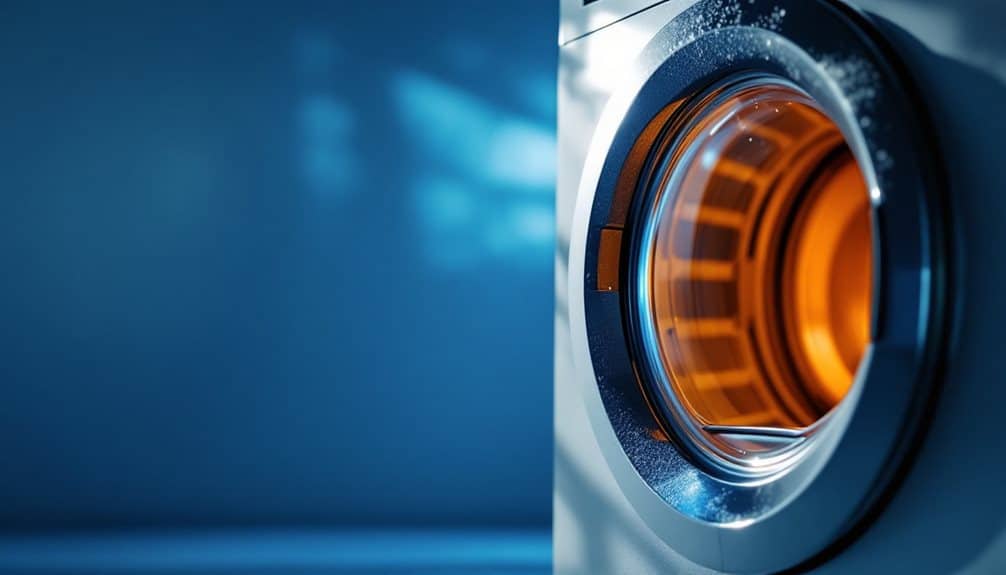
Your dryer used to be a speedy marvel, cranking out hot, fluffy clothes in record time – but now you’re stuck waiting, waiting, and waiting some more for those jeans to finally dry. What’s going on? It’s likely one of these culprits: overloading, a washer that’s not spinning out enough water, a dirty lint screen and vent system, or malfunctioning components. These issues reduce drying efficiency and increase moisture levels, making your dryer work harder and longer. Regular maintenance, such as inspecting the drum for lodged items or ensuring components are well-lubricated, can prevent these inefficiencies and extend the life of your dryer.
| Common Causes | Symptoms | Solutions |
|---|---|---|
| Overloading | Clothes take forever to dry | Load clothes properly, spread them out |
| Washer issues | Excessively wet clothes | Adjust washer settings, check spin cycle |
| Dirty lint screen | Reduced airflow, drying time increases | Clean lint screen, vent system annually |
Identify the problem, and you’ll be back to fluffy, quick-dried clothes in no time!
Large or Unusual Energy Bills
Staring down a ginormous energy bill, you’re probably wondering what on earth is sucking up all that juice – and if your wallet can take the hit. Well, your dryer might be the culprit. A wonky dryer can guzzle energy like it’s going out of style, especially if it’s running inefficiently or has an electrical malfunction. If your dryer is taking forever to dry clothes or is running constantly, it’s likely wasting energy and driving up your bills. Time to put on your detective hat and investigate! Check your dryer’s efficiency by ensuring you’re not overdrying clothes and that the lint filter is clean. Also, consider energy saving tips like line-drying clothes or shifting your dryer usage to off-peak hours. A more efficient dryer = a happier wallet! Regular maintenance, such as cleaning the lint filter, can prevent energy waste and extend the life of your dryer.
Foul Odors From the Dryer
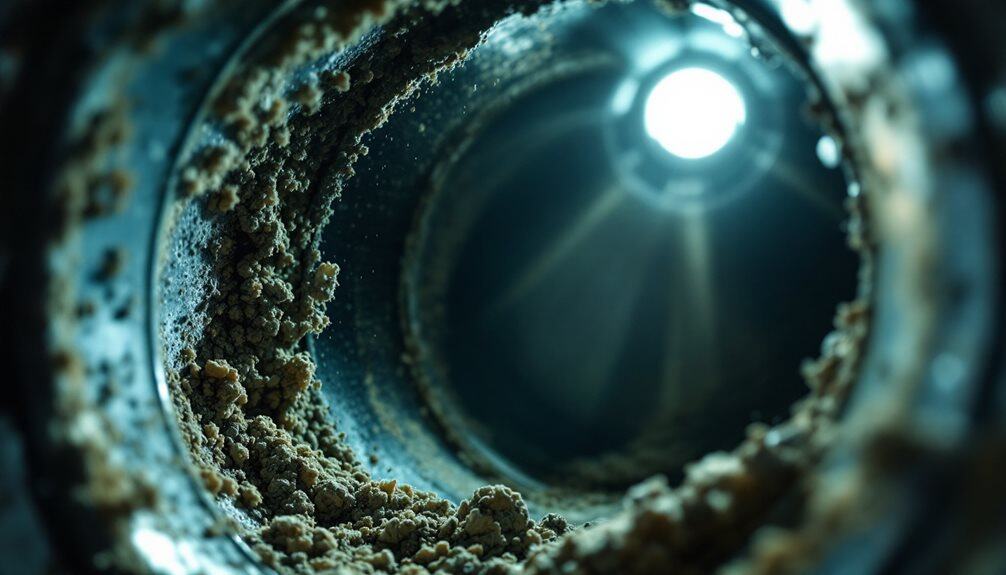
When you open your dryer door and are hit with a stench that could knock you off your feet, it’s time to investigate. That smell isn’t just a sign that your socks need a wash – it’s a cry for help from your dryer. Foul odors can be caused by lint buildup in the exhaust vent, smelly clothing, pest infiltration, or mold and mildew growth. Regular maintenance, such as annual dryer vent cleaning, is crucial to prevent these issues and ensure optimal dryer performance.
| Cause | Symptoms | Solution |
|---|---|---|
| Lint Buildup | Musty smell, poor airflow | Annual vent cleaning |
| Pest Infiltration | Odd noises, blockages | Regular vent cleaning, pest prevention |
| Mold and Mildew | Unpleasant odors, poor ventilation | Regular cleaning with bleach and vinegar |
Stay on top of lint maintenance and pest prevention to keep your dryer smelling fresh and working efficiently. Your nose (and your neighbors) will thank you!
In the midst of our laundry routines, it’s easy to overlook the telltale signs of a dryer that’s slowly giving up the ghost – until you’re standing in front of a ecstatic mess of damp clothes and a whopping energy bill. Newsflash: your dryer isn’t invincible! Its lifespan is around 10 to 15 years, depending on usage and maintenance. Heavy use can cut that down to 5 to 7 years. If you’re using your dryer daily, you’re accelerating its wear and tear. Proper maintenance, like regular cleaning, can extend its life. Keep an eye out for signs like heating issues, noisy operation, and drum problems. Don’t ignore these red flags! Regular maintenance checks and replacing worn-out parts can save you from costly repairs down the line. For example, a malfunctioning drum roller or drive belt can hinder spinning, necessitating immediate attention.

